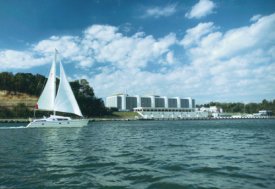
Electricity has been generated by burning fossil fuels (coal, oil, and gas) since before the turn of the century. For three decades, however, a non-fossil fuel, uranium, also has been used to produce electricity. The first nuclear power plant went into commercial operation in 1957, in Shippingport, Pennsylvania. Since then, the use of nuclear-generated electricity has grown substantially in the United States.
Uranium occurs in nature in combination with small amounts of other elements. Economically recoverable uranium deposits have been discovered principally in the western United States, Australia, Canada, Africa, and South America. A ton of uranium ore mined in the United States yields about seven pounds of Uranium oxide (U308). Uranium ore must be chemically processed, enriched, and formed into pellets before it can be used as a fuel.
Uranium fuel pellets are loaded into hollow tubes called fuel rods. Hundreds of fuel rods form fuel assemblies that, along with control rods, are placed into a nuclear reactor core and then submerged in water. Like fossil fuels, the resulting uranium fuel produces heat that turns water into steam. The steam turns blades in a turbine connected to an electrical generator. However, heat is produced differently in a nuclear reactor than in a fossil fuel power plant.
The nucleus of an atom consists of combinations of protons and neutrons--each of about equal weight. Energy in a nuclear reactor is derived from a process called nuclear fission in which a neutron strikes the nucleus of a uranium atom and is absorbed. The absorption of the neutron makes the nucleus unstable, causing it to split into two atoms of lighter elements and release heat and new neutrons. The heat is used to produce electricity while the neutrons potentially can be absorbed by other atoms of uranium, resulting in more nuclear fissions. This continuing process of fissioning is called a chain reaction. It is sustained because, for every atom of uranium fissioned by a neutron, new neutrons are released to continue the process.
 In 1996, nuclear power plants increased throughout the world with 32 countries now using nuclear power to produce electricity. Worldwide, this amounts to 23 percent of the total electric generation in those countries and 17 percent of worldwide electricity generation. Commercial uses of nuclear fuel also became available for the first time from dismantled Russian warheads in 1996.
In 1996, nuclear power plants increased throughout the world with 32 countries now using nuclear power to produce electricity. Worldwide, this amounts to 23 percent of the total electric generation in those countries and 17 percent of worldwide electricity generation. Commercial uses of nuclear fuel also became available for the first time from dismantled Russian warheads in 1996.
The U.S. connected its last domestic commercial plant, the Watts Bar 1 Plant, in 1996, and five other new nuclear reactors were added worldwide to electric grids bringing the number of commercial nuclear units to 442. Nineteen ninety-six also saw 45 nuclear units already under construction (South Korea and Russia are building seven plants each), and an additional 27 units are in the planning stages throughout the world. China and Japan are scheduling the majority of units to be completed sometime between 2002-2010. Nuclear power is expected to grow annually at 3.4 percent through 2015 in China, India, Japan, South Korea and Taiwan, accounting for more than 70 percent of projected new worldwide nuclear power. The Energy Information Administration expects nuclear power to increase worldwide until 2010 and then to fall in 2015 as some U.S. units may close at the end of their current operating license periods.
For information on nuclear power usage in Maryland's power plants, see the Power Plant Research Program of the Maryland Department of Natural Resources.
